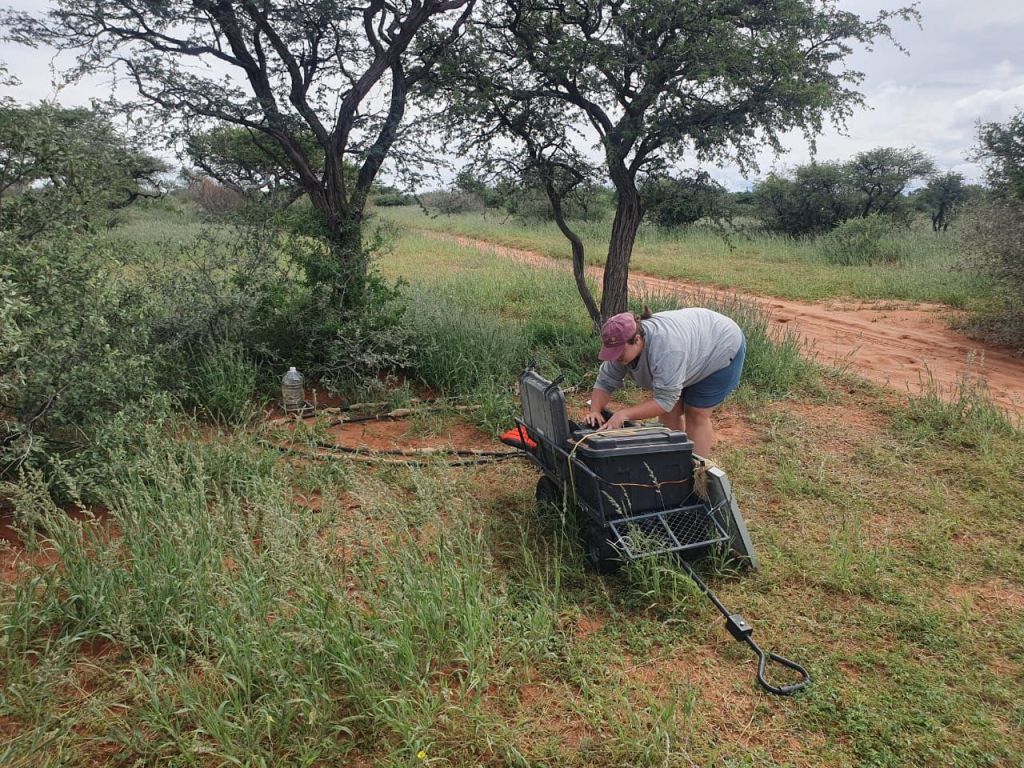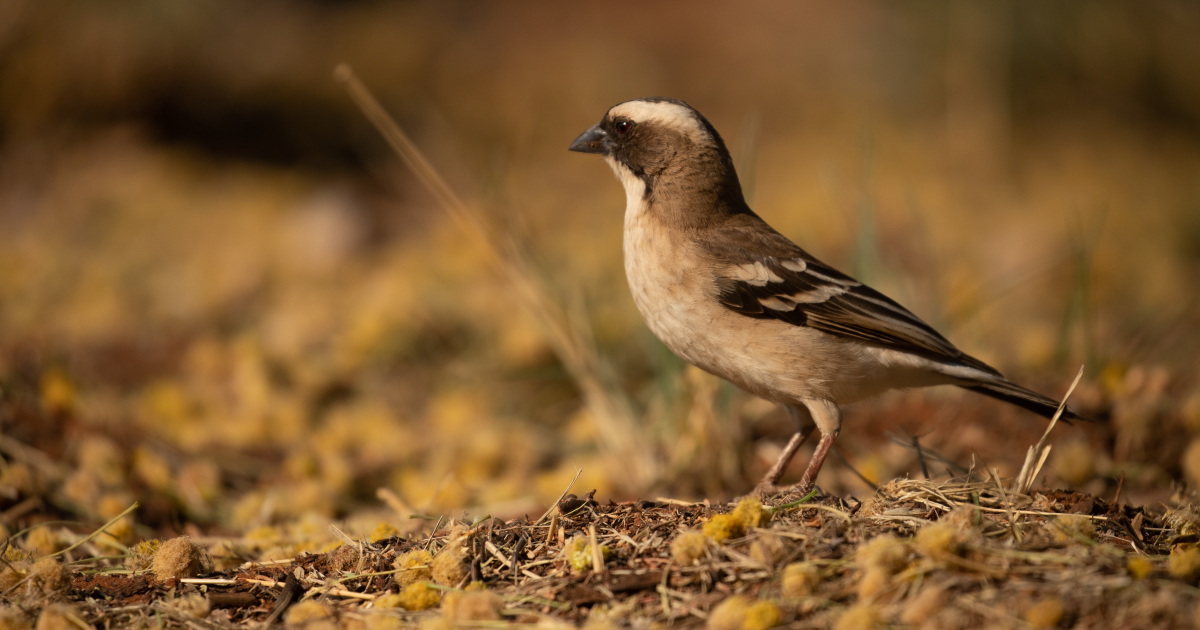On the sun-seared plains of the southern Kalahari, where the landscape stretches out in hues of rust and gold, Natasha Balmer is watching birds. Not just any birds, but White-browed Sparrow-Weavers: chatty, sociable, nest-bound birds whose lives may hold critical clues to a question scientists are urgently trying to answer: how will climate change affect life?
Balmer, a PhD researcher from Rhodes University, has chosen a little-known phenomenon, piospheres, as her lens. And what she’s finding suggests that small-scale degradation today may be a stark preview of what widespread desertification will look like under climate change.
What’s a piosphere, anyway?
“If you haven’t heard of a piosphere, you’re not alone,” Balmer says, laughing. “Even in biology, it’s a niche term.”
Piospheres are zones of intense ecological wear and tear that radiate out from artificial water points or feeding stations, particularly in arid regions. In these central spots, where thirsty herbivores congregate, vegetation is trampled, seeds crushed, soils compacted and chemically altered by dung and urine. The damage fans outward in a gradient, slowly easing until the natural landscape picks up again.
The term was coined in the 1950s and is most often discussed in relation to livestock, especially in South Africa’s arid farming regions. But Balmer’s work explores the ripple effects of piospheres on native wildlife, specifically, birds, and what they may reveal about a hotter, drier future.

A desert bird with a story to tell
The White-browed Sparrow-Weaver (Plocepasser mahali) is a highly social, largely insectivorous bird that roosts in messy ball-like nests in arid savannas and deserts across southern Africa. Crucially for Balmer’s study, they’re creatures of habit, sticking to small home ranges and sleeping in the same trees each night.
“This makes them ideal for physiological studies,” she says. “You know exactly where they are, and you can recapture individuals repeatedly, which means you can track changes over time.”
Using specialised tags, Balmer can monitor the birds’ body temperature as they moved about their habitat. Her goal: to see how birds cope with heat and food scarcity in degraded versus non-degraded areas, and to determine what might happen when degradation becomes the norm.
The hidden cost of water
In the Kalahari’s game reserves, water doesn’t always mean life. At least, not for everything.
To support high densities of large herbivores, particularly endangered species like black rhino, land managers instal artificial watering holes. These water points are essential for animals that can’t migrate freely across fenced reserves. But they come with ecological costs.
“You end up with very unnatural concentrations of animals in one spot,” Balmer explains. “And that leads to extreme degradation of the land around those water points.”
ISome piospheres extend up to two kilometres from a central waterhole. Near the centre, the land is bare and hard-packed. Vegetation is minimal. Insects are few. And shade, so vital for animals in the heat, is in short supply.
That spells trouble for birds like the sparrow-weaver.
“…So what’s the fix? Balmer doesn’t claim to have all the answers, but she points to active management, like that being trialled at Tswalu, as a promising path.
“They’ve closed around 30 unnecessary watering holes,” she says. “Not to eliminate access to water, but to reduce excess degradation. They’re monitoring animal numbers, watching where the pressure is heaviest, and adapting accordingly.”

Birds on the edge
Balmer’s study at Tswalu Kalahari Reserve compared sparrow-weavers living near artificial watering holes to those in relatively undisturbed areas. Her methods were part behavioural ecology, part physiology: she tracked how birds foraged, whether they sought shade, how their body temperature fluctuated throughout the day, and how their body condition changed over time.
“What we saw was that birds in the degraded areas were working harder,” she says. “They foraged longer in the open sun, where there’s less cover and fewer insects. Eventually, they start panting, holding their wings away from their bodies to cool down. That’s heat stress.”
And it’s not just behaviour. Balmer’s data, still being crunched, suggest that birds in piospheres may struggle to maintain weight during extreme heat, even with access to water.
The reason? Heat regulation is energy-intensive. So is foraging. In degraded areas with few insect prey and little shade, the trade-off becomes stark: burn energy trying to stay cool and find food, or retreat and risk going hungry.
Meanwhile, birds in healthier zones can afford to forage more selectively, rest in shade, and maintain their condition.
A glimpse into the future
While piospheres are localised, the mechanisms that create them, heat, overgrazing, aridity, are the same drivers behind desertification, which is expected to increase dramatically as climate change escalates.
“This research gives us a kind of microcosm,” Balmer explains. “We can look at how birds are coping right now in degraded zones and use that as a proxy for what might happen across entire landscapes in the future.”
It’s not just sparrow-weavers. Other birds, like granivores, need to fly daily to find both food and water. In hotter, drier conditions, that commute gets costlier. Balmer warns that as degradation spreads, the energy margins for these birds will shrink, and some may vanish altogether.

A canary in the Kalahari
Balmer’s research is still ongoing, but her message is already clear: arid-zone birds are on the frontlines of climate change. Their struggles in piospheres may soon become the reality across much wider swaths of land.
“These birds are tough,” she says. “They’ve evolved to deal with heat and scarcity. But there’s a limit. And if we want to understand where that limit is, and how to keep ecosystems functioning, we need to start listening to them.”
In a warming world, the quiet panting of a sparrow-weaver under a thorn tree might be one of the clearest warnings we get.
Sidebar: what Is desertification?
Desertification isn’t about deserts taking over; it’s about degradation. In arid and semi-arid zones, overgrazing, climate change, and poor land management strip vegetation, compact soils, and reduce biodiversity. Piospheres offer a glimpse of this process on a small scale, one that could expand rapidly in a hotter future.
Yves Vanderhaeghen writes for Jive Media Africa, science communication partner of Oppenheimer Generations Research and Conservation.
- Tracking the Shangani Wanderer - June 18, 2025
- Rescue, rehabilitate, release: tracking the comeback of South Africa’s pangolins - June 18, 2025
- Fewer weavers, fewer homes: why nest builders matter in the Kalahari - June 17, 2025


